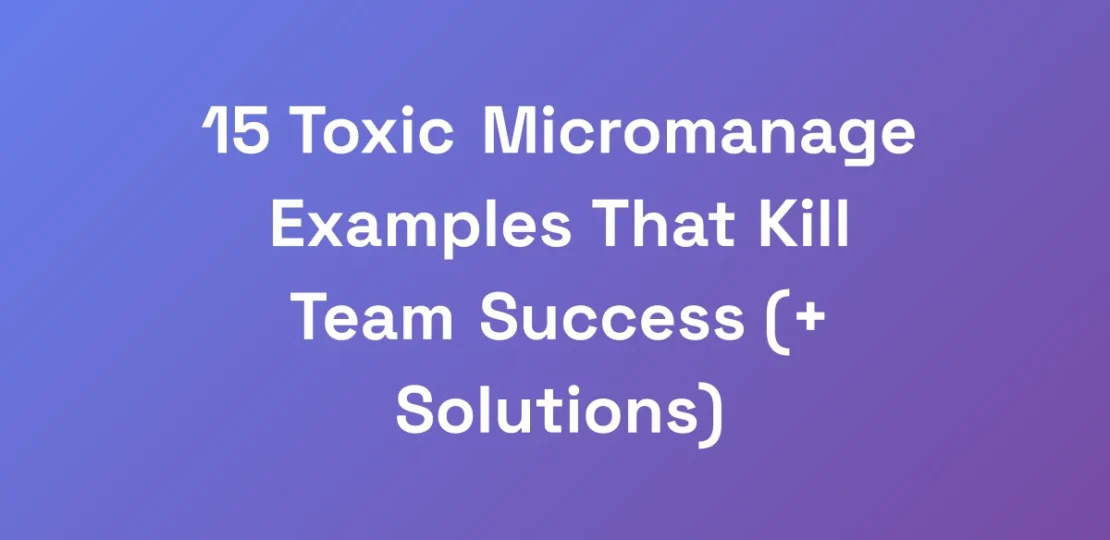15 Toxic Micromanage Examples That Kill Team Success (+ Solutions)
March 17, 2025 | by [email protected]

Ever felt the suffocating grip of someone constantly watching your every move at work?
Micromanagement isn’t just a buzzword—it’s a toxic leadership style that can cripple teams and drain success.
We’ve seen it firsthand: leaders who can’t let their teams breathe hinder not only productivity but also innovation and morale.
Imagine trying to run a race with someone blocking your path at every step. Frustrating, right?
That’s what micromanagement feels like to your team—stifling their potential and enthusiasm.
The challenges are real and the impact is profound. Let’s uncover the 15 toxic micromanage examples that could be sabotaging your team’s success and explore effective solutions to break free from this detrimental cycle.
The Hidden Cost of Micromanagement: Real-World Impact
Let me hit you with some truth: micromanagement isn’t just annoying – it’s a silent profit killer that’s bleeding your business dry. We’ve seen countless companies lose millions because leaders couldn’t stop breathing down their team’s necks.
Here’s what’s wild: studies show that micromanaged employees are 96% more likely to look for new jobs. When you micromanage, you’re not just losing productivity – you’re literally pushing your best talent out the door.
The real cost? It’s not just the obvious metrics; it’s the invisible damage to innovation, creativity, and team morale that’s killing your business slowly.
The Psychological Impact on Team Performance
Micromanagement creates a climate of distrust and anxiety within teams. When leaders hover excessively, employees feel undervalued and stifled.
Consider this: Constant oversight erodes confidence, making team members second-guess their decisions and hesitate to take initiative.
This psychological strain leads to decreased engagement and a lack of ownership over tasks, which are vital for high performance.
Financial Losses from Micromanagement
Micromanagement doesn’t just drain morale—it drains finances. Excessive oversight leads to inefficiencies and slows down workflows, directly impacting the bottom line.
Businesses can lose billions annually due to wasted resources and misallocated time spent on unnecessary check-ins and approvals.
Moreover, high turnover rates associated with micromanagement mean increased costs in recruiting and training new employees.
Productivity Metrics in Micromanaged Teams
When teams are micromanaged, productivity plummets. Employees spend more time reporting and less time delivering.
Studies indicate that 35% of employees report feeling stressed and less productive due to micromanagement by their bosses.
This stress not only hampers current output but also diminishes long-term potential by stifling creativity and innovation.
Employee Turnover Statistics
Micromanagement is a top culprit behind high employee turnover. With 59% of workers having been managed by a micromanager, it’s clear this practice is driving talent away.
Moreover, 68% of these workers report decreased morale, and 55% say their productivity has taken a hit, pushing them to seek better work environments.
Replacing employees can cost up to 33% of their annual salary, adding significant financial strain to businesses.
Long-term Business Growth Impact
In the long run, micromanagement stunts business growth. By stifling innovation and preventing employees from fully utilizing their skills, companies limit their ability to adapt and thrive.
Moreover, the ongoing loss of talent means valuable knowledge and expertise leave with your top performers, creating gaps that hinder strategic initiatives.
Ultimately, businesses stuck in a micromanagement rut find it challenging to scale effectively and compete in the market.
Clear-Cut Examples of Micromanagement in Action
We’re about to dive into the nitty-gritty—showing you exactly what micromanagement looks like in the real world. No fluff, just raw examples we’ve personally witnessed destroying companies.
The most dangerous part? Many leaders are doing these things without even realizing it.
From the manager who demands hourly updates on basic tasks to the executive who can’t let their team send a single email without approval – these behaviors are killing your team’s ability to perform.
But here’s the kicker: once you recognize these patterns, you can’t unsee them. And that’s the first step to fixing this profit-draining problem.
The Email Approval Nightmare
Imagine needing a stamp of approval for every email your team sends. This not only slows down communication but also creates bottlenecks.
Emails are the lifeblood of efficient operations. When leaders control every message, it hampers swift decision-making and frustrates employees.
This overbearing control stifles open communication and creates unnecessary delays in project timelines.
The Constant Check-In Syndrome
Picture a manager who requires hourly updates on every task. Constant check-ins can make employees feel like they’re not trusted to manage their own work.
This behavior disrupts workflow and creates a stressful environment, reducing overall productivity and job satisfaction.
Employees become preoccupied with reporting rather than executing their responsibilities effectively.
The Process Micromanager
Some leaders think that controlling every aspect of a process ensures success. However, this rigid oversight often leads to a lack of flexibility and creativity.
When employees can’t adapt processes to fit unique situations, it hampers problem-solving and inhibits innovation.
This type of micromanagement forces teams to follow orders blindly, leading to inefficiencies and decreased morale.
The Decision Bottleneck
Leaders who refuse to delegate decision-making power create a significant bottleneck. Every choice, big or small, requires their input.
This centralization of authority slows down operations and prevents employees from feeling empowered to take initiative.
As a result, projects stall, and the organization becomes less agile in responding to changes and challenges.
The Timeline Obsessor
Obsessing over strict deadlines without allowing flexibility can cause undue stress and burnout among team members.
This micromanagement style disregards the reality that creativity and problem-solving often require time and thoughtful consideration.
Rigidity in timelines stifles innovation and can lead to lower quality work as employees rush to meet unrealistic expectations.
The Detail Dictator
Focusing excessively on minor details diverts attention from the bigger picture. Leaders who micromanage often lose sight of strategic goals.
This obsession with perfection in every tiny aspect can prevent teams from delivering projects on time and within scope.
Employees may feel their efforts are undervalued, leading to disengagement and decreased motivation.
The Psychology Behind Micromanagement Behaviors
Why do smart, capable leaders fall into the micromanagement trap? It’s not what you think. Having built and scaled multiple businesses, we’ve discovered that micromanagement usually stems from a deep-rooted fear of failure.
But here’s the truth bomb: your need for control is actually creating the very failures you’re trying to prevent.
Understanding the psychological triggers behind micromanagement isn’t just interesting – it’s crucial for breaking free from these destructive patterns and scaling your business effectively.
Fear-Based Leadership Patterns
Fear drives many micromanagers. The fear of outcomes not aligning with their expectations makes them cling to control.
This fear inhibits their ability to trust their team, leading to over-involvement in tasks that should be delegated.
Addressing this fear is the first step toward fostering a healthier, more autonomous work environment.
Control Issues in Management
Some leaders have an inherent need to control every aspect of their team’s work. This can stem from a lack of confidence in their team’s abilities.
These control issues prevent employees from taking ownership and can stifle their professional growth.
Recognizing and addressing these control tendencies is essential for empowering teams.
Trust Deficit Syndrome
Micromanagement often reflects a fundamental lack of trust in team members.
When leaders don’t trust their employees to perform tasks independently, it fosters a toxic work environment where collaboration and innovation suffer.
Building trust is key to breaking the cycle of micromanagement.
Perfectionism’s Role
Perfectionists fear that anything less than flawless results will tarnish their reputation or the company’s standing.
This fear drives them to oversee every detail, leaving little room for team members to experiment or make autonomous decisions.
Encouraging a culture that values progress over perfection can mitigate this issue.
Past Experience Impact
Negative past experiences can lead leaders to micromanage as a defensive mechanism.
If previous projects failed due to lack of oversight, leaders might become overly controlling in subsequent endeavors.
Learning from past experiences without letting fear dictate current management styles is crucial for growth.
Proven Solutions to Stop Micromanaging Today
Time for some real talk: breaking free from micromanagement isn’t about “letting go” – it’s about building systems that scale.
We’re going to share the exact framework we’ve used to help companies multiply their revenue while actually reducing management oversight.
The key? Creating what we call “freedom within framework” – clear boundaries and metrics that let your team thrive without constant supervision.
When you implement these solutions, you’ll see an immediate boost in both team performance and your bottom line.
The Trust-Building Framework
Trust is the cornerstone of any successful team. Start by delegating responsibilities and giving team members the autonomy to make decisions.
Encourage open communication and show appreciation for their efforts. This builds mutual respect and reduces the urge to control every detail.
Remember, trust is earned over time, and it starts with small steps.
Delegation Mastery System
Effective delegation is more than just assigning tasks. It’s about understanding your team’s strengths and assigning responsibilities accordingly.
Provide the necessary resources and support, and then step back. Let your team take ownership of their tasks and learn from their experiences.
This not only empowers employees but also frees up your time to focus on strategic initiatives.
Clear Success Metrics
Set clear, measurable goals for your team. When everyone’s on the same page about what success looks like, there’s less need for constant oversight.
Use these metrics to evaluate performance and provide feedback. This creates accountability without micromanaging processes.
Transparency in expectations fosters a sense of direction and purpose among team members.
Effective Reporting Structures
Implement streamlined reporting structures that provide the information you need without overwhelming your team. Additionally, consider leveraging SEO optimization automation tools to enhance efficiency.
Regular, concise updates can keep you informed while allowing your team the freedom to manage their workload independently.
Use tools and technologies that facilitate efficient communication and information sharing.
Team Empowerment Strategies
Empower your team by encouraging decision-making and problem-solving at all levels.
Provide training and development opportunities that enhance their skills and confidence.
When employees feel empowered, they’re more engaged and motivated to contribute meaningfully to the company’s success.
Leadership Mindset Shifts
Transforming from a micromanager to an empowering leader requires a shift in mindset.
Adopt a growth-oriented perspective that values learning and development over perfection.
Embrace the idea that mistakes are opportunities for growth, not reasons for punishment.
Conclusion
Micromanagement is more than just an annoying habit—it’s a destructive force that can undermine your team’s success and your company’s bottom line.
We’ve explored the 15 toxic micromanage examples that can cripple your organization, from constant check-ins to decision bottlenecks.
But it’s not all doom and gloom. By understanding the psychological roots of micromanagement and implementing proven solutions like trust-building frameworks and delegation mastery systems, we can break free from these detrimental patterns.
It’s time to foster a work environment where your team feels empowered, trusted, and motivated to excel.
Ready to transform your leadership style and unlock your team’s full potential? Start implementing these strategies today and watch your business thrive.
What micromanagement challenges have you faced in your organization? Share your experiences and solutions in the comments below—we’d love to hear how you’re turning the tide!
RELATED POSTS
View all


